In today’s digital age, the convergence of e-commerce and live-streaming technology has given birth to a new phenomenon: live e-commerce. This innovative approach to online shopping allows businesses to engage with customers in real-time, providing interactive experiences and seamless purchasing opportunities. As a result, it is the fastest-growing trend in e-commerce in the APAC region, with China setting the scene for the rest of the world, including developed markets such as the US and the UK.
We are witnessing a transformation as younger generations increasingly seek instant gratification. Consequently, e-commerce companies must prioritise integrating purchasing capabilities within immersive experiences and entertainment.
Some sceptics still argue that live buying on social media platforms is not yet a lucrative endeavour, resulting in specific platforms and features being overlooked. Even within our network, companies face challenges in meeting the demands of their clients on media such as TikTok. However, it is crucial to recognise the tremendous potential of social commerce, given its staggering market size.
Recent data reveals that global social commerce sales amounted to $492 billion in 2021, projected to nearly triple by 2025, reaching $1.2 trillion. This remarkable growth underscores the escalating significance of social commerce as a pivotal sales channel—over half of the surveyed businesses intended to embrace social commerce as a new sales channel in 2023.
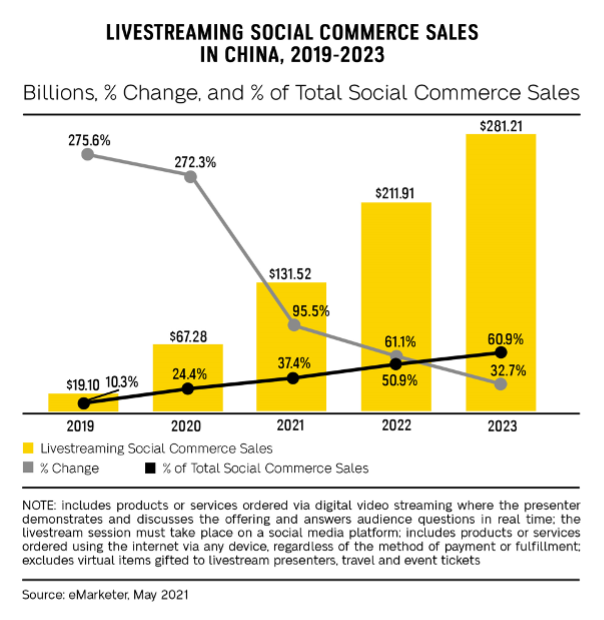
Social media platforms facilitate direct commerce, providing valuable opportunities for brands to engage with their audiences. Platforms like Facebook Shops, Instagram Shopping, Pinterest Shopping, and TikTok Shop offer intuitive interfaces that empower businesses to showcase their products and services directly to their target customers. In addition, by leveraging the innate shopping impulses of users at the moment, these platforms enable businesses to capitalise on immediate purchase desires and convert them into sales.
By 2024, the e-commerce profit from live shopping will increase threefold, up to $35 billion in the US.
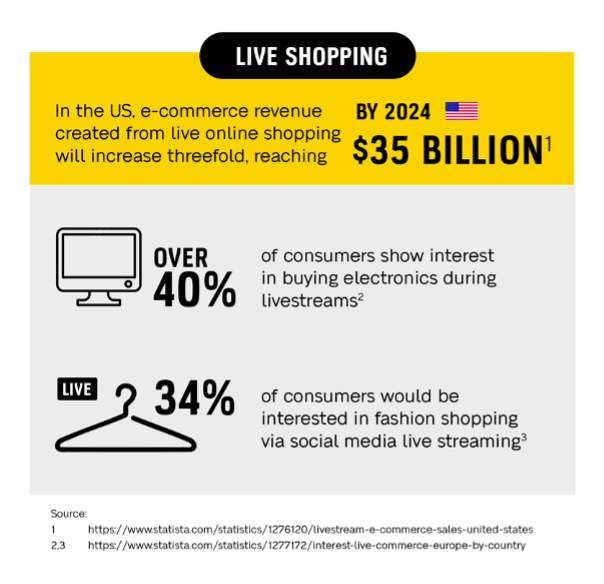
In 2020, a significant number of consumers in Poland, Spain, France, and the United Kingdom, surpassing 40%, demonstrated a keen interest in purchasing electronics through live streams on e-commerce sites or apps. Moreover, 34% of European shoppers expressed their enthusiasm for shopping for fashion items via live streams on popular social media platforms. These statistics underscore the undeniable significance of live shopping as a pivotal component of Go-To-Market strategies for direct-to-consumer (D2C) companies, highlighting its substantial impact and potential for success.
Integrating e-commerce features into social media platforms has brought about a revolutionary transformation in how brands engage with consumers. By offering seamless access to product information, pricing, and purchasing options, social commerce empowers businesses to significantly improve their ability to convert social media interactions into sales. As these platforms continue to gain widespread popularity and social commerce becomes increasingly prevalent, brands have a formidable tool to drive revenue and elevate customer experiences to new heights.
Let’s explore some popular platforms where live commerce thrives, allowing businesses to establish meaningful connections with their target audience and boost sales effectively.
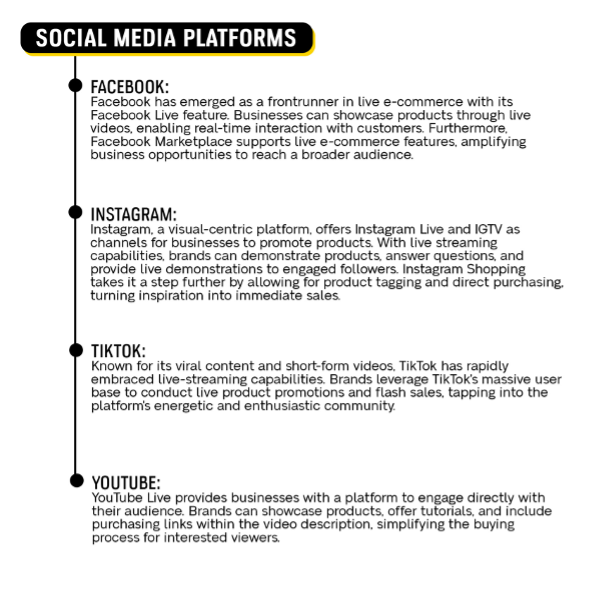
Thanks to its powerful Facebook Live feature, Facebook has emerged as a frontrunner in the realm of live commerce. This functionality lets businesses present their products in engaging live videos, fostering real-time customer interaction. Furthermore, Facebook Marketplace is vital in supporting live commerce, providing companies with expanded opportunities to connect with a broader audience and maximise their business prospects.
Instagram, a visual-centric platform, offers multiple avenues for businesses to promote their products, including Instagram Live, Instagram Video, and Instagram Reels. Leveraging these features, brands can engage with their followers through live streaming, captivating videos, and short, entertaining Reels. This enables businesses to showcase their products, answer questions in real-time, provide live demonstrations, and deliver compelling content that drives engagement. To further enhance the shopping experience, Instagram Shopping allows for seamless product tagging and direct purchasing, transforming inspiration into immediate sales.
TikTok
TikTok, renowned for its viral and captivating short-form videos, has swiftly embraced the power of live-streaming. Brands now harness TikTok’s vast user base to host live product promotions and exciting flash sales, effectively tapping into the platform’s vibrant and enthusiastic community. This dynamic approach allows businesses to capitalise on the energetic nature of TikTok and engage with a large audience in real-time, driving brand awareness and fostering a sense of urgency among viewers.
YouTube
YouTube Live provides businesses with a platform to engage directly with their audience. Brands can showcase products, offer tutorials, and include purchasing links within the video description, simplifying the buying process for interested viewers.
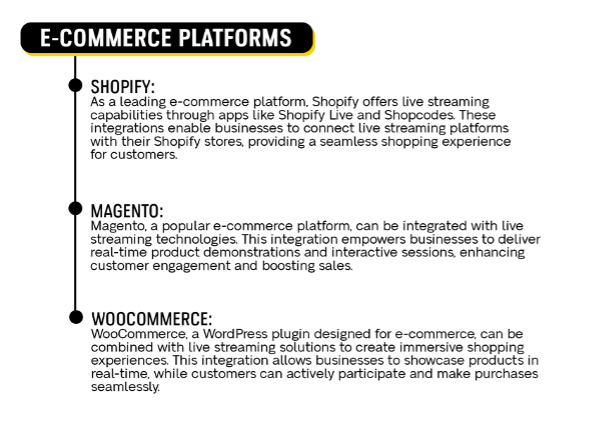
Shopify
As a leading e-commerce platform, Shopify offers live streaming capabilities through apps like Shopify Live and Shopcodes. These integrations enable businesses to connect live streaming platforms with their Shopify stores, providing a seamless shopping experience for customers.
Magento
Magento, a popular e-commerce platform, can be integrated with live-streaming technologies. This integration empowers businesses to deliver real-time product demonstrations and interactive sessions, enhancing customer engagement and boosting sales.
WooCommerce
WooCommerce, a WordPress plugin designed for e-commerce, can be combined with live-streaming solutions to create immersive shopping experiences.
This integration allows businesses to offer a dynamic and engaging platform where customers can explore products, ask questions, and complete transactions effortlessly.
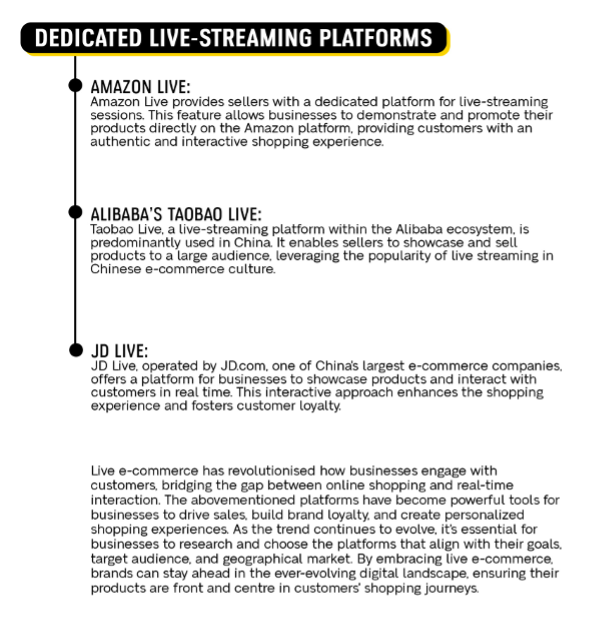
Amazon Live
Amazon Live provides sellers with a dedicated platform for live-streaming sessions. This feature allows businesses to demonstrate and promote their products directly on the Amazon platform, providing customers with an authentic and interactive shopping experience.
Alibaba’s Taobao Live
Taobao Live, a live-streaming platform within the Alibaba ecosystem, is predominantly used in China. It enables sellers to showcase and sell products to a large audience, leveraging the popularity of live streaming in Chinese e-commerce culture.
JD Live
JD Live, operated by JD.com, one of China’s largest e-commerce companies, offers a platform for businesses to showcase products and interact with customers in real-time. This interactive approach enhances the shopping experience and fosters customer loyalty.
Live commerce has ushered in a ground-breaking era where businesses can seamlessly connect with customers, merging online shopping with real-time interaction. These platforms have become potent tools for driving sales, fostering brand loyalty, and delivering tailored shopping experiences. As this trend continues to evolve, businesses must conduct thorough research and select platforms that align with their goals, target audience, and geographic market. By embracing live commerce, brands can proactively stay ahead in the ever-evolving digital landscape, ensuring their products take centre stage in customers’ shopping journeys.


